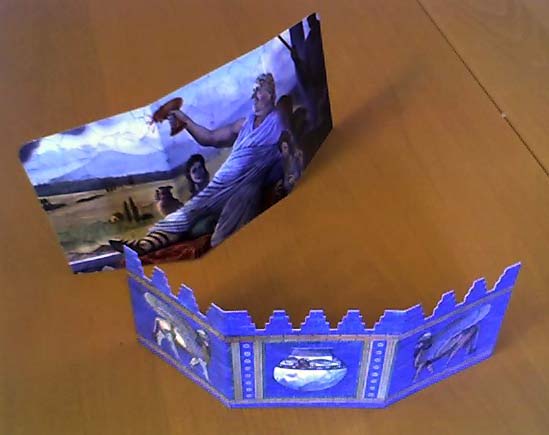A Better Game Screen

Typical game screens. These are from Gloria Mundi and Tigris and Euphrates.
A fair number of games have some sort of privacy screen. It's usually a flat piece of card stock with some kind of printing on it, and folds in two places. You bend the sides in to create a trapezoid-y shape, and stand it up to hide your things. They're usually pretty unstable, and over time, the paper at the fold lines gets weaker and weaker, so the screen won't stay folded. It straightens out, and falls over. Most unsatisfactory.

My game screens, in 'tall' and 'short'.
So I came up with something better. My screens have angled bases to keep their center of gravity away from the edges (as do some of the other game screens out there), and a short "roof" that greatly improves how well they keep other people from seeing your stuff, but much more important, they have a positive locking mechanism to keep the sides at the correct angle no matter how worn the folding hinge gets. Well, until you've folded it and unfolded it so much that it just flat-out falls apart. I can't help you with that problem.
 Comparing screen designs.
Comparing screen designs.
Why is it important to keep the sides at a fixed angle? You see, the example traditional screens, like mine, are cut so they lean backwards a bit when folded. The problem is, the "best" (that is, most stable) angle to cut the bottom of the sides depends on how much of an angle they're folded back to, and without my locking mechanism, there's really no control over that. Also, whenever you put the screens away, they get folded flat, and repeated folding and unfolding weakens the hinge. Pretty soon, the screens start falling backwards with the slightest puff of air.

The tall screen takes one full sheet of paper. The shorter screen can be printed two per sheet. Instructions for assembling and using them are included in the PDF file. The subtle details in the shape of the interlocking tabs make an enormous difference in how well the screens work, so try to cut exactly along the cut lines. I recommend a nice sharp craft knife and a straight edge, although they can be cut out with scissors as well. Three spots are especially important to cut precisely. The slot at the top of the side wall (marked in red on the diagram) is a thin wedge with a rounded nose. Both the wedgy shape and the rounded bit are important. On the top edge, you want to make sure you cut the point (marked in green) all the way in. It's not a catastrophe if you cut a little too far, although the more overcut you do, the weaker the lock will be, and the more likely it'll wear out at some point. Finally, if you get the curve right (marked in blue), then it will lock and unlock smoothly.
Individuals are welcome to download, print, and use these with their various board games or what not as they like, as long as you don't obscure or remove my little notices, and you don't sell them to people or use them in a commercial product. If you are a game designer or manufacturer, or you'd like to include these in a commercial product or use them in some commercial way, please drop me a line; I'm sure we can work something out.

Game Screen by Dave Howell is licensed under a Creative Commons Attribution-NonCommercial 3.0 Unported License.
To Games Page. To Home Page.


 Comparing screen designs.
Comparing screen designs.
